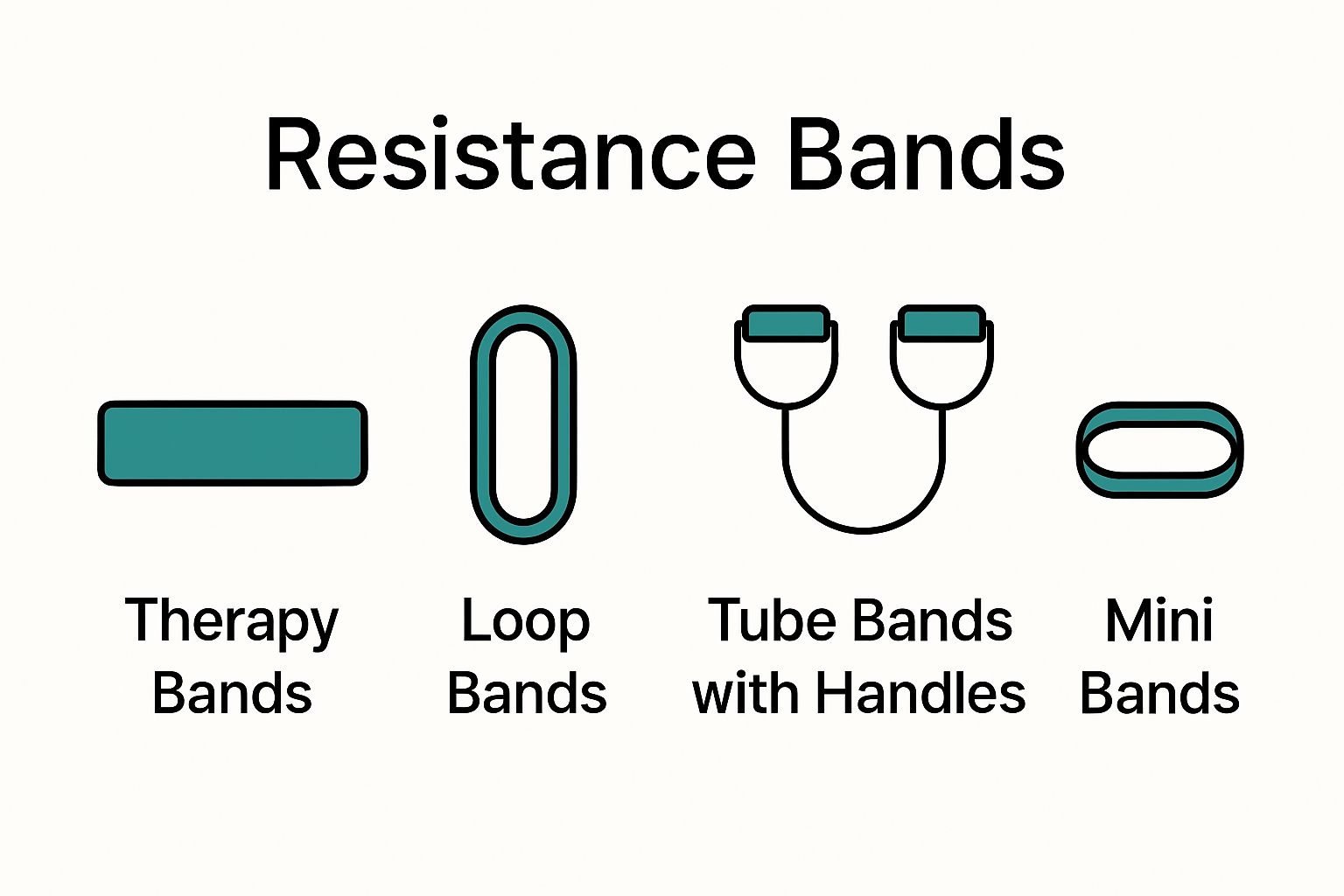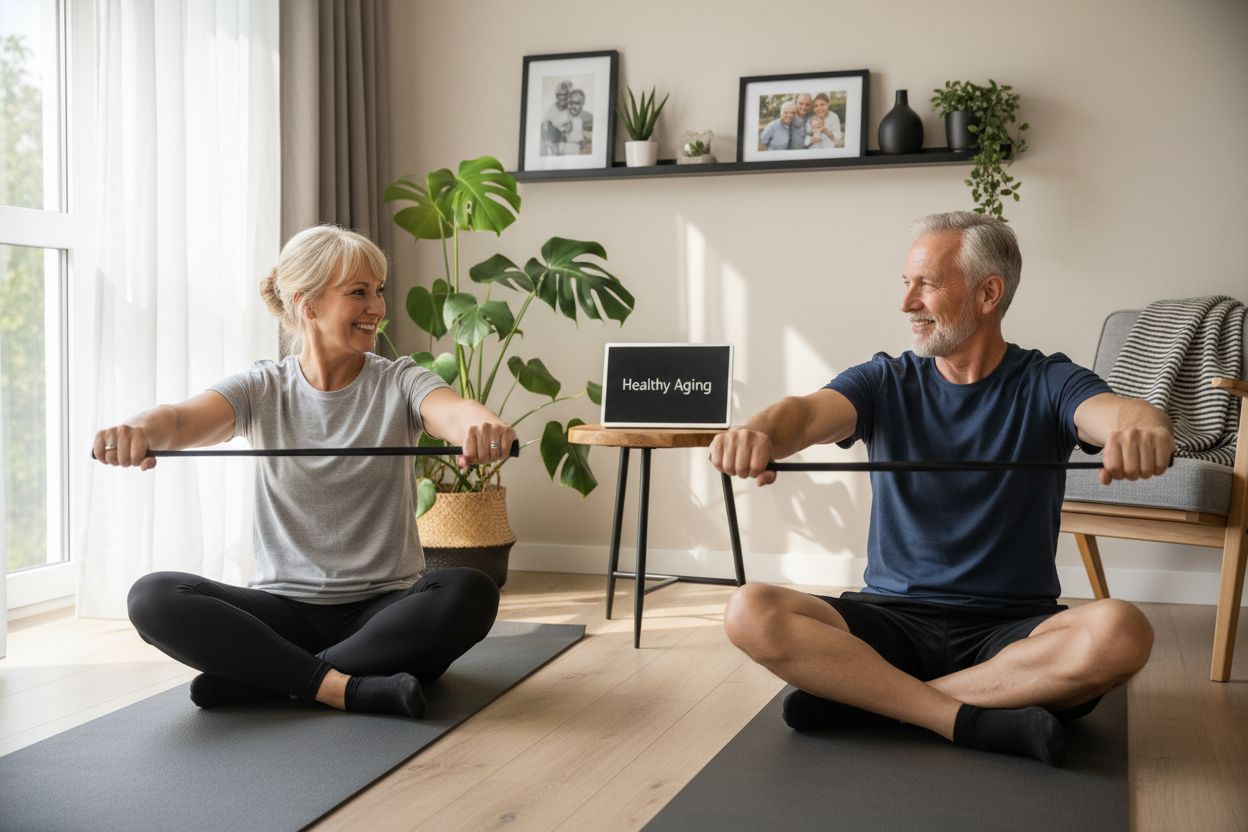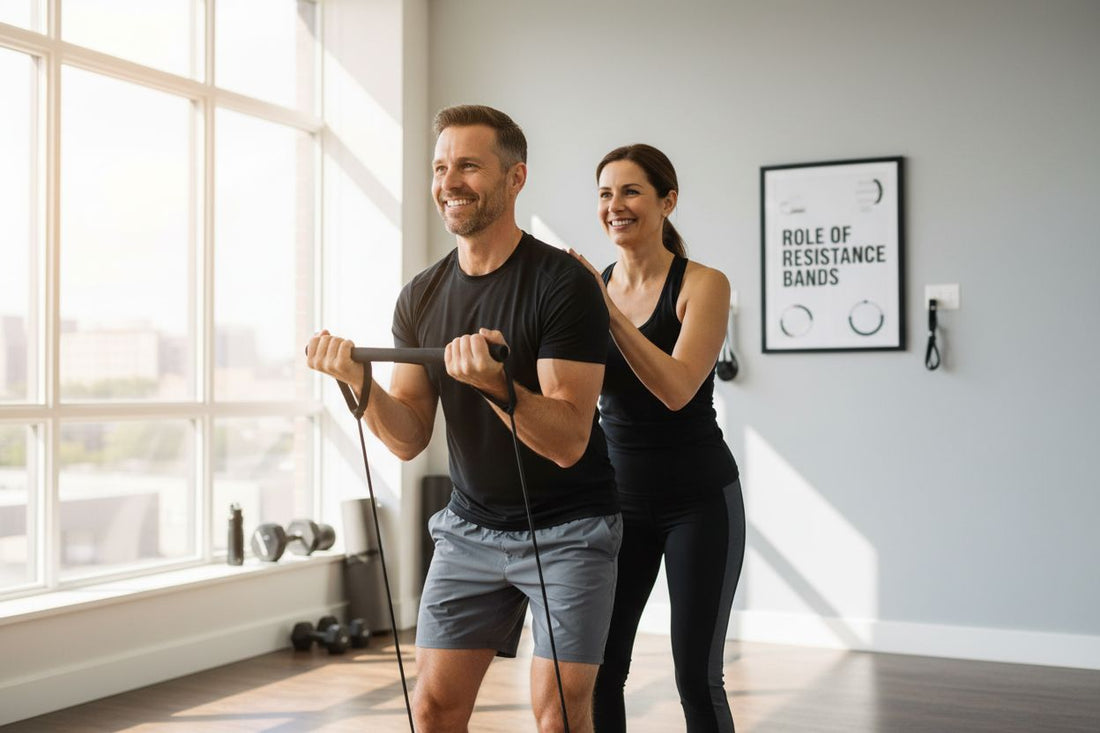Resistance bands are everywhere in fitness right now and it is not just a trend. These simple tools have been shown to provide strength gains nearly identical to traditional weight training according to recent clinical studies. Most people think you need a gym packed with machines for real results but these stretchy loops might just give you better muscle engagement and flexibility right in your living room.
Table of Contents
- What Are Resistance Bands And How Do They Work?
- The Importance Of Resistance Bands For Healthy Aging
- How Resistance Bands Enhance Strength And Flexibility
- Integrating Resistance Bands Into Everyday Fitness Routines
Quick Summary
| Takeaway | Explanation |
|---|---|
| Resistance bands provide variable tension for muscle engagement | Continuous resistance throughout movements leads to improved muscle activation and strength development compared to traditional weights. |
| Ideal for older adults to maintain strength | They effectively counteract muscle loss due to aging while minimizing joint stress, promoting safer workouts. |
| Resistance bands enhance flexibility and functional strength | They support dynamic movements that improve range of motion and mimic real-life activities, benefiting overall mobility. |
| Scalable for various fitness levels and goals | Bands can be adjusted for different tensions, making them suitable for beginners to advanced users without needing multiple weights. |
| Portable and economical fitness solution | Lightweight design allows for easy transport and access to strength training anywhere, promoting consistent exercise routines. |
What are Resistance Bands and How Do They Work?
Resistance bands represent an innovative and versatile fitness tool designed to provide variable tension during physical exercise. These elastic bands create constant muscular engagement by generating progressive resistance throughout movement ranges, making them an exceptional alternative to traditional weight training methods.
Understanding the Mechanics of Resistance Bands
Unlike rigid workout equipment, resistance bands generate tension through their inherent elasticity. When stretched, these flexible bands create increasing resistance proportional to the distance they are pulled. This unique characteristic means muscles experience continuous tension during exercises, which can lead to enhanced muscle activation and strength development.
The core mechanism involves potential energy transformation. As you stretch the band, potential energy increases, requiring more muscular effort to maintain the movement. According to research from the National Strength and Conditioning Association, this continuous tension can stimulate muscle growth more effectively than traditional weight training by maintaining consistent muscle engagement throughout the entire exercise motion.
Types and Resistance Levels
Resistance bands come in multiple varieties, each designed for specific fitness goals and user capabilities
 :
:
- Therapy bands: Lightweight and flexible, ideal for rehabilitation and gentle strength training
- Loop bands: Closed circular design perfect for lower body and core exercises
- Tube bands with handles: Versatile for full body workouts and mimicking cable machine movements
- Mini bands: Compact bands excellent for targeted muscle group engagement
The role of resistance bands extends beyond simple muscle strengthening. They provide a low impact workout option that reduces joint stress while offering scalable intensity levels. By selecting bands with different tension ratings, individuals can progressively challenge their muscular system without requiring multiple sets of weights.
Below is a comparison table summarizing the key types of resistance bands and their common features to help you select the most suitable option for your fitness goals.
| Type of Resistance Band | Description | Ideal Uses |
|---|---|---|
| Therapy Bands | Lightweight, flat, and stretchy | Rehabilitation, gentle strength training |
| Loop Bands | Closed circular design, varies in thickness | Lower body and core workouts |
| Tube Bands with Handles | Cylindrical band with attached handles | Full body workouts, cable machine mimicry |
| Mini Bands | Small loops, compact and portable | Targeted muscle group activation |
Physical therapists and fitness professionals appreciate resistance bands for their portability, affordability, and adaptability.
VIDEO:video_content] [Clinical research published in the Journal of Strength and Conditioning Research demonstrates that resistance band training can produce comparable strength gains to traditional weight training when implemented correctly.
Whether you are recovering from an injury, seeking a convenient home workout solution, or wanting to supplement existing training routines, resistance bands offer a comprehensive approach to building strength and maintaining muscular fitness.
The Importance of Resistance Bands for Healthy Aging
As individuals progress through midlife and beyond, maintaining physical fitness becomes increasingly critical for preserving independence, mobility, and overall quality of life. Resistance bands emerge as a powerful tool specifically suited to address the unique fitness challenges experienced by adults over 40.
Preserving Muscle Mass and Functional Strength
With aging, natural muscle decline known as sarcopenia becomes a significant concern. Muscle loss can begin as early as age 30, accelerating after 40, which can dramatically impact daily functioning and metabolic health. Resistance bands provide a gentle yet effective method to counteract this physiological process by enabling targeted muscle engagement with minimal joint stress.
The low impact nature of resistance band exercises allows older adults to build and maintain muscle strength without risking injury. Research from the Canadian Centre for Activity and Aging demonstrates that consistent resistance training can help maintain muscle mass, improve balance, and reduce the risk of falls among older adults.
Comprehensive Health Benefits Beyond Muscle Preservation
Resistance band training offers multifaceted health advantages for mature individuals:
- Improves bone density and reduces osteoporosis risk
- Enhances joint flexibility and range of motion
- Supports cardiovascular health through controlled resistance exercises
- Helps manage chronic conditions like arthritis and diabetes
- Promotes better insulin sensitivity and metabolic function
Unlike traditional weight training, resistance bands provide variable and adjustable tension, making them an ideal fitness solution for individuals with different physical capabilities. The bands accommodate various fitness levels and can be easily modified to match individual strength and comfort.
The following table organizes the comprehensive health benefits that resistance band training provides for adults over 40, helping to highlight their broad impact on well-being.
| Health Benefit | Explanation |
|---|---|
| Maintains muscle mass and functional strength | Counters age-related muscle loss with targeted resistance |
| Enhances bone density | Reduces osteoporosis risk through weight-bearing activities |
| Improves joint flexibility and range of motion | Supports gentle movement and stretching |
| Supports cardiovascular health | Encourages moderate-intensity, controlled resistance workouts |
| Manages chronic conditions | Beneficial for arthritis, diabetes, and metabolic health |
| Promotes psychological well-being | Boosts confidence, reduces risk of cognitive decline |
| Enables safe, low-impact exercise | Minimizes joint strain, supports injury prevention |
Psychological and Practical Advantages
Beyond physical benefits, resistance bands contribute to psychological well-being. The sense of achievement from progressive strength training can boost confidence and mental resilience. Moreover, their lightweight, portable design eliminates barriers to consistent exercise, enabling workouts at home, during travel, or in limited spaces.
Clinical studies in the Journal of Aging and Physical Activity have consistently highlighted the positive correlation between regular resistance training and improved cognitive function, suggesting that these exercises support not just physical but also mental health as we age.
For adults over 40, resistance bands represent more than just an exercise tool.
 They are a comprehensive approach to maintaining physical vitality, independence, and quality of life through safe, adaptable, and effective strength training.
They are a comprehensive approach to maintaining physical vitality, independence, and quality of life through safe, adaptable, and effective strength training.
How Resistance Bands Enhance Strength and Flexibility
Resistance bands offer a unique approach to developing muscular strength and improving overall body flexibility through their innovative design and adaptive resistance mechanism. Unlike traditional weight training, these elastic tools provide continuous tension that challenges muscles throughout the entire range of motion, creating a comprehensive workout experience.
Biomechanical Principles of Muscle Engagement
Muscle activation occurs differently with resistance bands compared to conventional weights. The elastic properties generate increasing tension as the band stretches, which means muscles experience progressive resistance during exercises. This mechanism creates constant muscular engagement that stimulates more comprehensive muscle fiber recruitment.
Research from the American Council on Exercise indicates that this continuous tension can lead to more effective muscle development and improved neuromuscular coordination. The variable resistance challenges muscles to work harder at different points in the movement, promoting more balanced strength development.
Comprehensive Movement and Flexibility Enhancement
Resistance bands excel at supporting dynamic movement patterns that simultaneously build strength and enhance flexibility. Key benefits include:
- Promoting full range of motion exercises
- Encouraging multi-directional muscle activation
- Supporting functional movement patterns
- Reducing risk of joint strain
- Enabling gentle yet effective stretching techniques
The bands allow for complex movement patterns that mimic real-world physical activities, making them superior to isolated, linear weight training approaches. Functional movement training becomes more accessible, helping individuals develop practical strength applicable to daily life activities.
Progressive Adaptability and Muscle Development
One significant advantage of resistance bands is their inherent scalability. By changing band tension, grip position, or body positioning, individuals can progressively challenge their muscular system without requiring multiple equipment sets. This adaptability makes resistance bands particularly effective for continuous fitness progression.
The Journal of Strength and Conditioning Research highlights that consistent resistance band training can produce comparable strength gains to traditional weight training when implemented with proper technique and progressive overload principles.
For adults seeking a versatile, joint-friendly approach to maintaining strength and flexibility, resistance bands represent an intelligent fitness solution that adapts to individual physical capabilities and fitness goals.
Integrating Resistance Bands into Everyday Fitness Routines
Transforming fitness routines requires strategic integration of versatile tools like resistance bands. These adaptable fitness accessories offer a seamless approach to developing comprehensive strength training practices that can be customized for various fitness levels and personal health objectives.
Creating a Balanced Workout Framework
Resistance bands provide exceptional workout versatility by enabling individuals to design comprehensive exercise programs targeting multiple muscle groups simultaneously. Their lightweight and portable nature allows for creating structured workout routines that can be performed anywhere from home living rooms to travel accommodations.
According to the National Academy of Sports Medicine, effective resistance band integration involves developing a balanced approach that incorporates exercises targeting different muscle groups and movement patterns. The key is developing a systematic routine that progressively challenges muscular strength and endurance.
Strategic Exercise Selection and Progression
Designing an effective resistance band workout requires thoughtful exercise selection that ensures comprehensive muscle engagement:
- Upper body exercises like chest presses and shoulder rotations
- Lower body movements including squats and leg extensions
- Core stabilization techniques such as rotational movements
- Rehabilitation and mobility-focused stretching sequences
- Dynamic warmup and cooldown protocols
Progression becomes crucial in maintaining workout effectiveness. By gradually increasing resistance levels, changing exercise angles, and modifying movement patterns, individuals can continuously challenge their muscular system and prevent fitness plateaus.
Complementing Existing Fitness Practices
Resistance bands excel at supplementing and enhancing existing workout routines. They can be seamlessly integrated with bodyweight exercises, traditional strength training, and even rehabilitation protocols. Research published in the Journal of Sports Science and Medicine demonstrates that resistance band training can effectively complement weight training by providing additional muscle activation and supporting joint stability.
The adaptability of resistance bands makes them particularly valuable for individuals seeking flexible fitness solutions that accommodate varying physical capabilities, space constraints, and personal fitness goals. Whether recovering from injury, maintaining midlife fitness, or seeking low-impact strength training, resistance bands offer a comprehensive and accessible approach to physical wellness.
Experience Strength and Flexibility That Grows With You
Is it getting harder to maintain muscle and flexibility as you age? The article explained how resistance bands offer joint-friendly tension, constant muscular engagement, and unique adaptability for people over 40. You learned that resistance bands support healthy aging by helping preserve muscle mass, manage chronic health concerns, and restore day-to-day confidence without the risk of heavy traditional weights. If you are ready to prioritize independence and energy as the years advance, we have solutions designed for your life stage and Canadian lifestyle. Our wide range of high-quality resistance bands and fitness products were chosen to work in perfect harmony with healthy aging routines like yours.

Don’t wait for muscle loss or mobility issues to slow you down. Visit Real Healthy Haven now for expert insights, curated equipment, and the supportive tools you need for an active future. Make your next workout safer, more effective, and perfectly suited to your body’s evolving needs.
Frequently Asked Questions
What is the best way to use resistance bands for strength training?
Start by selecting a band that matches your fitness level and the specific exercise you’re doing. Gradually incorporate resistance band exercises into your routine, ensuring you maintain correct form and control—aim for 8-12 repetitions of each exercise for optimal strength gains.
How can resistance bands enhance my flexibility?
Resistance bands allow you to perform dynamic stretching and full range of motion exercises, which promotes better flexibility. Include stretching routines with the bands in your workouts, focusing on holding each stretch for 15-30 seconds to improve your overall flexibility over time.
Can resistance bands help with muscle preservation as I age?
Yes, resistance bands are effective for countering muscle loss associated with aging by providing low-impact resistance training. Incorporate resistance band exercises into your routine at least two to three times a week to help maintain muscle mass and functional strength.
How do I create a balanced workout using resistance bands?
To create a balanced workout, select exercises that target multiple muscle groups, such as upper body, lower body, and core. Develop a full routine that includes 5-10 exercises, aiming to complete the circuit 2-3 times for comprehensive strength development.
Are resistance bands appropriate for rehabilitation?
Yes, resistance bands are often used in rehabilitation programs due to their low-impact nature and variable resistance. Work with a physical therapist to incorporate resistance band exercises that target the injured area while promoting range of motion and strength recovery.
How can I progressively increase resistance when using bands?
You can increase resistance by switching to a thicker band, adjusting your grip position, or altering the angle of your body during exercises. Aim for progressive overload by making these adjustments every few weeks to ensure continuous muscle engagement and strength development.



